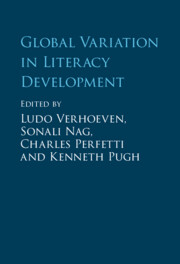Book contents
- Global Variation in Literacy Development
- Global Variation in Literacy Development
- Copyright page
- Contents
- Figures
- Tables
- Contributors
- Abbreviations
- 1 Introduction
- Part I Regional Variations
- 2 Sociocultural Variation in Literacy Development in Canada and the United States
- 3 Literacy Contexts and Literacy Development in South America
- 4 Postcolonial Literacy Development in the Caribbean
- 5 Literacy Development in Europe
- 6 Literacy Education and Development in Russia
- 7 Literacy Development and Language of Instruction in Sub-Saharan Africa
- 8 Literacy and Linguistic Diversity in Multilingual India
- 9 Literacy Development in East Asia
- 10 Literacy and Linguistic Diversity in Australia
- Part II Neurobiological and Ecological Markers
- Index
- References
3 - Literacy Contexts and Literacy Development in South America
from Part I - Regional Variations
Published online by Cambridge University Press: 23 November 2023
- Global Variation in Literacy Development
- Global Variation in Literacy Development
- Copyright page
- Contents
- Figures
- Tables
- Contributors
- Abbreviations
- 1 Introduction
- Part I Regional Variations
- 2 Sociocultural Variation in Literacy Development in Canada and the United States
- 3 Literacy Contexts and Literacy Development in South America
- 4 Postcolonial Literacy Development in the Caribbean
- 5 Literacy Development in Europe
- 6 Literacy Education and Development in Russia
- 7 Literacy Development and Language of Instruction in Sub-Saharan Africa
- 8 Literacy and Linguistic Diversity in Multilingual India
- 9 Literacy Development in East Asia
- 10 Literacy and Linguistic Diversity in Australia
- Part II Neurobiological and Ecological Markers
- Index
- References
Summary
This chapter presents detailed demographics on the status of literacy development in South America from the perspective of its educational and sociopolitical context. Despite several efforts to achieve proper literacy development levels, challenges and obstacles remain for several developing countries, including most of South America. In this continent, underachievement encompasses sociocultural, economic, and political factors that affect - in varyingdegrees - education in general, and especially reading instruction policies. Substantial efforts have been made so far, and South America, with a diverse population of near 431 million, has achieved several educational goals in the past decade. According to the Organisation for Economic Co-operation and Development, primary school coverage has become almost universal, and average years of schooling approach those of the developed countries. Nevertheless, even if illiteracy has largely decreased, the quality of literacy skills remain poor for both children and adults. This chapter discusses public policies and the choice of reading-instruction methods, one aspect that has likely had a strong influence on the development of reading skills throughout several countries of this continent.
- Type
- Chapter
- Information
- Global Variation in Literacy Development , pp. 56 - 69Publisher: Cambridge University PressPrint publication year: 2023

